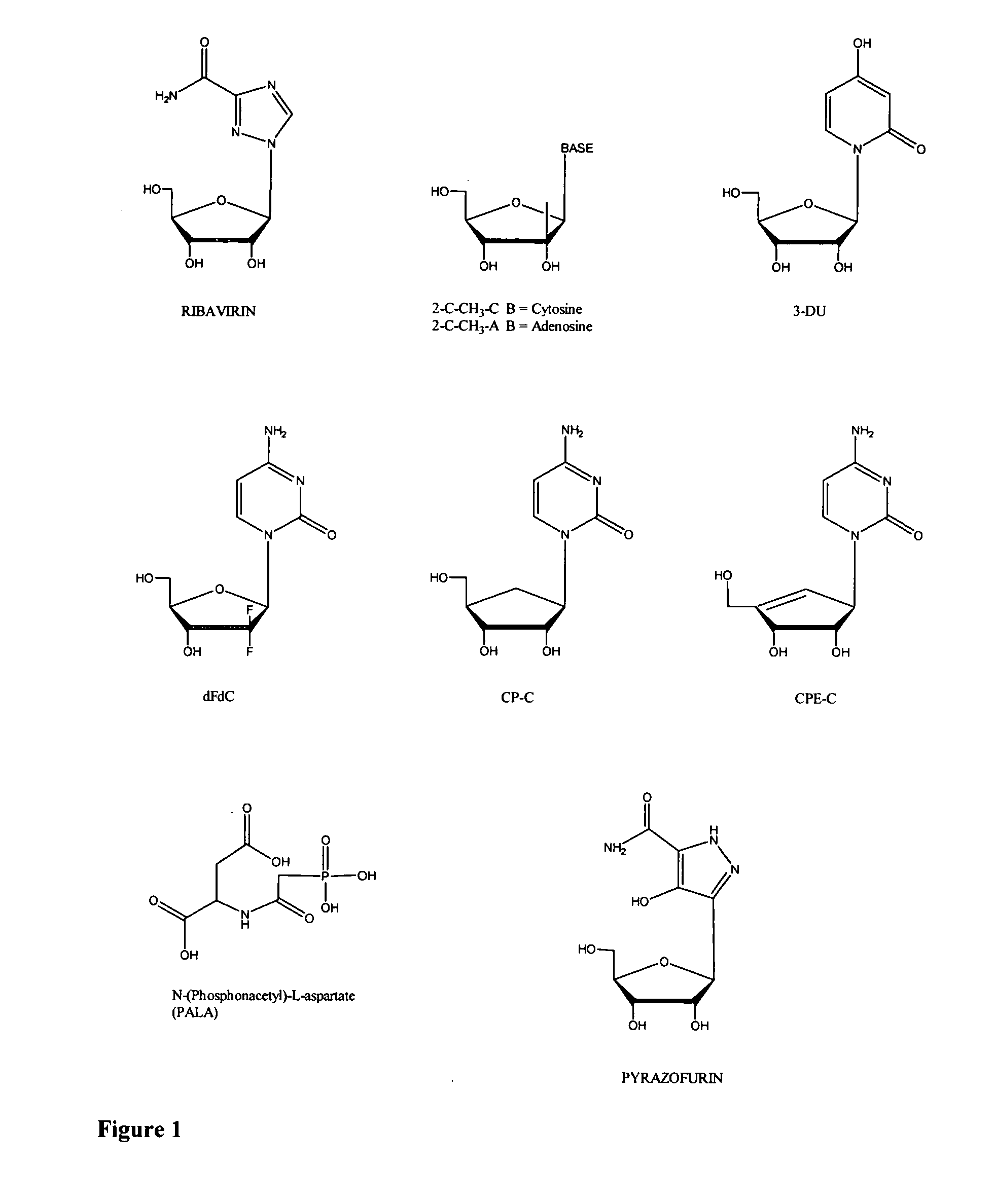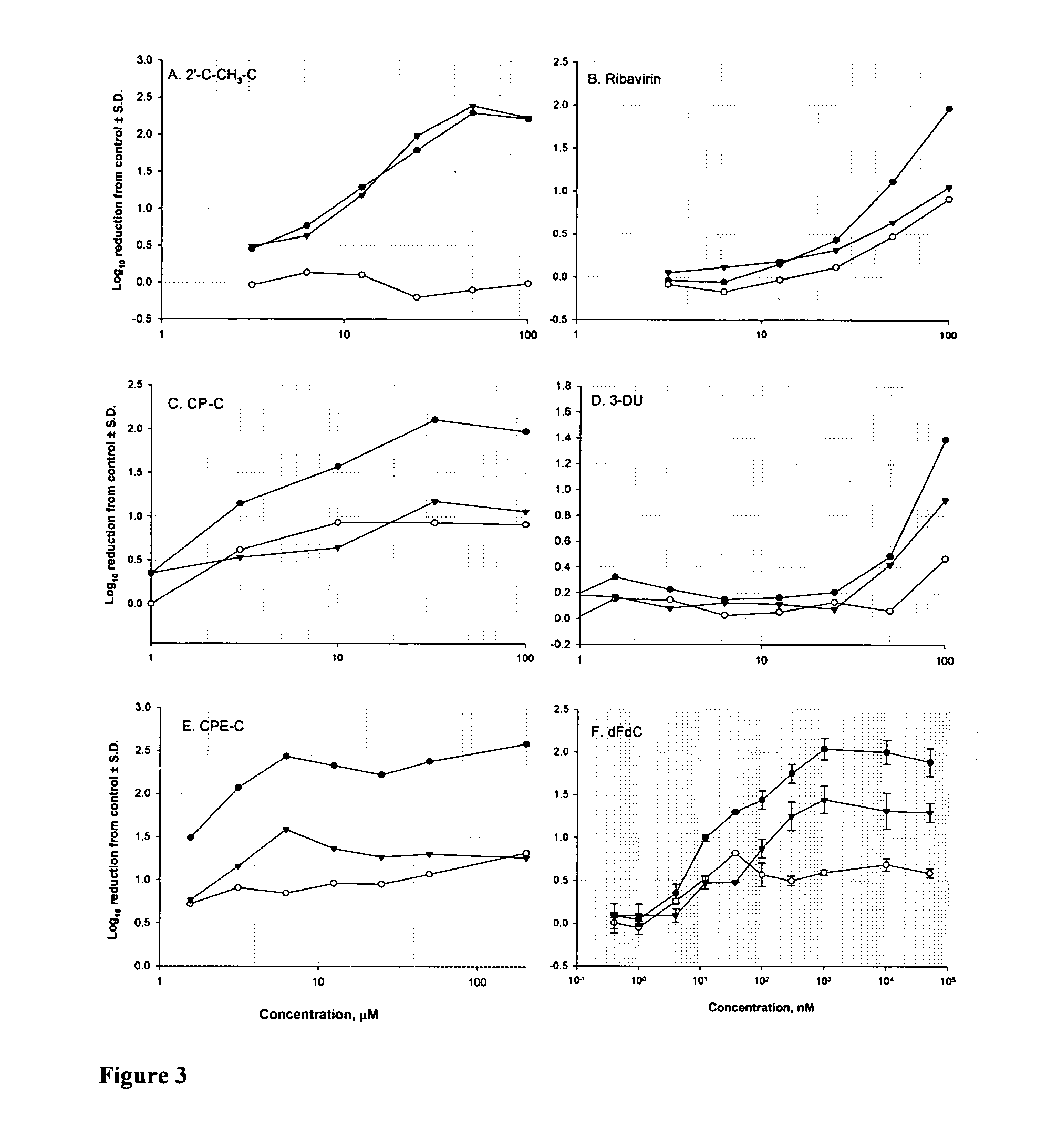Compounds for the treatment of flaviviridae infections
a technology of compounds and flaviviridae, applied in the field of compounds and methods for the treatment of flaviviridae infections, can solve the problems of cirrhosis, liver failure, hepatocellular carcinoma and other problems, and achieve the effects of reducing the risk of cirrhosis
- Summary
- Abstract
- Description
- Claims
- Application Information
AI Technical Summary
Benefits of technology
Problems solved by technology
Method used
Image
Examples
example 1
HCV-replicon RNA-containing Huh7 cells (Clone A cells; Apath, LLC, St. Louis, Mo.) were kept in exponential growth in DMEM media (high glucose, no pyruvate) containing 10% fetal bovine serum, 1× non-essential amino acids (100 units / ml), penicillin-streptomycin (100 μg / ml), glutamine (0.292 mg / ml), and G418 (1,000 μg / ml). Antiviral assays were performed in the same medium without G418. It was shown that the absence of G418 during antiviral testing has no effect on the levels of HCV-RNA (Stuyver, et al. “A ribonucleoside analogue that blocks the replication of bovine viral diarrhea and hepatitis C viruses in culture” Antimicrob. Agents Chemother., January 2003, 47 (1), 244-254). Cells were seeded in a 6-well plate at 105 cells per well. Candidate antiviral compounds were tested as described (Stuyver, et al. “A ribonucleoside analogue that blocks the replication of bovine viral diarrhea and hepatitis C viruses in culture” Antimicrob. Agents Chemother., Jan...
example 2
Growth of the Replicon Cells and Observation of HCV RNA Levels.
Evaluating candidate anti-HCV compounds in the replicon system is hampered by the fact that only cells in logarithmic growing conditions can be used. Cells that reach confluency—and hence enter into a G0 / G1 cell cycle arrest—cannot maintain stable amounts of the replicon RNA levels per cell, as evidenced by a steady decrease in HCV RNA but not rRNA (FIG. 2) (Stuyver, et al. “A ribonucleoside analogue that blocks the replication of bovine viral diarrhea and hepatitis C viruses in culture” Antimicrob. Agents Chemother., January 2003, 47 (1), 244-254). This suggests that cellular factors that are required for replicon RNA replication and / or translation vary in abundance and become limited in resting cells. One of these factors might be the availability of sufficient levels of NTPs to support replicon synthesis.
Considerable incubation time-dependent fluctuations in the amounts of HCV RNA in replicon cells were previousl...
example 3
Control Experiments: Anti-HCV Effect of Previously Established Compounds in the HCV Replicon System.
Currently, IFN-α and ribavirin are the only approved drugs for treatment of HCV-infected patients. Besides these approved molecules, several others have been claimed to exert specific antiviral activity (Carroll, et al. “Inhibition of hepatitis C virus RNA replication by 2′-modified nucleoside analogs” J. Biol. Chem. 2003, 27, 27; Sommadossi, J. P., and P. Lacolla “Methods and compositions for treating hepatitis C virus” International Patent Application WO 01 / 190121, Idenix Pharmaceuticals; Walker, M. P., and Z. Hong “HCV RNA-dependent RNA polymerase as a target for antiviral development” Curr Opin Pharmacol, 2002, 2, 534-40).
In a series of control experiments, IFN-α-2a, ribavirin, 2′-C—CH3—C and 2′-C—CH3-A were tested over a range of concentrations for their ability to reduce the HCV RNA levels in a dose-response manner in exponentially growing replicon cells after 4 days of com...
PUM
| Property | Measurement | Unit |
|---|---|---|
| Mass | aaaaa | aaaaa |
| Pharmaceutically acceptable | aaaaa | aaaaa |
Abstract
Description
Claims
Application Information
 Login to View More
Login to View More - R&D
- Intellectual Property
- Life Sciences
- Materials
- Tech Scout
- Unparalleled Data Quality
- Higher Quality Content
- 60% Fewer Hallucinations
Browse by: Latest US Patents, China's latest patents, Technical Efficacy Thesaurus, Application Domain, Technology Topic, Popular Technical Reports.
© 2025 PatSnap. All rights reserved.Legal|Privacy policy|Modern Slavery Act Transparency Statement|Sitemap|About US| Contact US: help@patsnap.com



